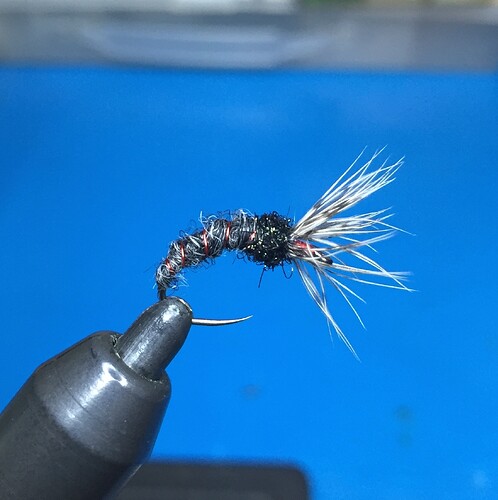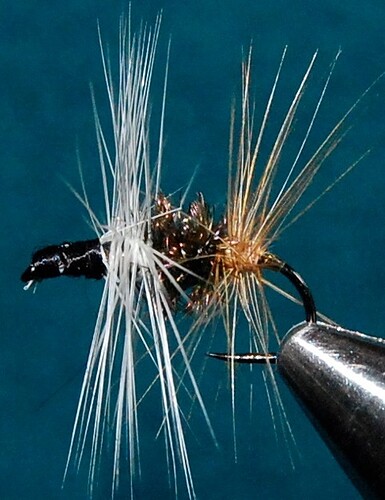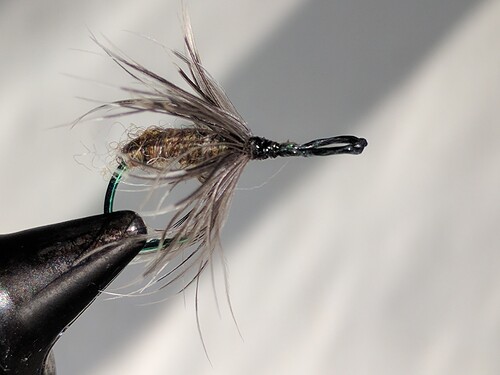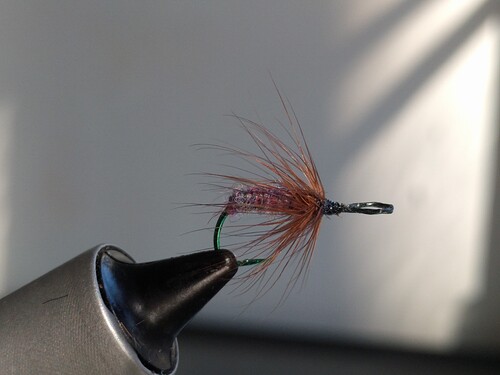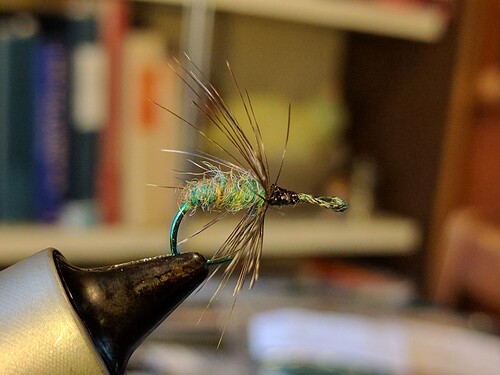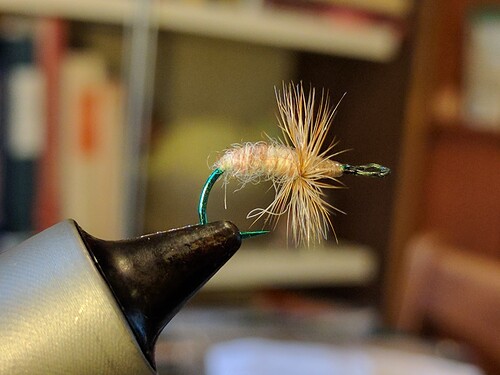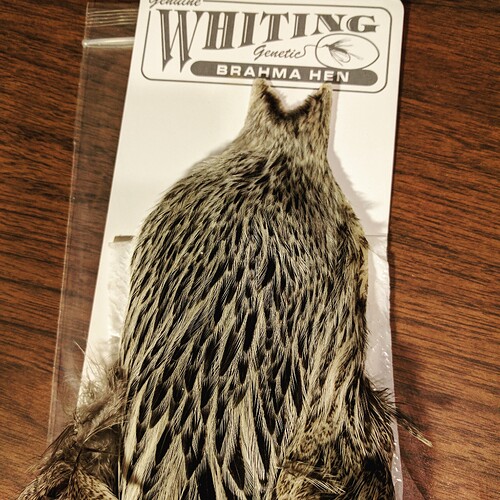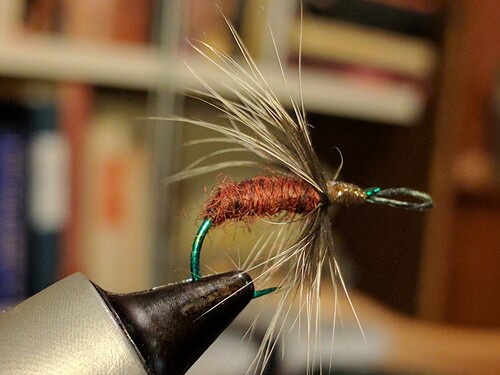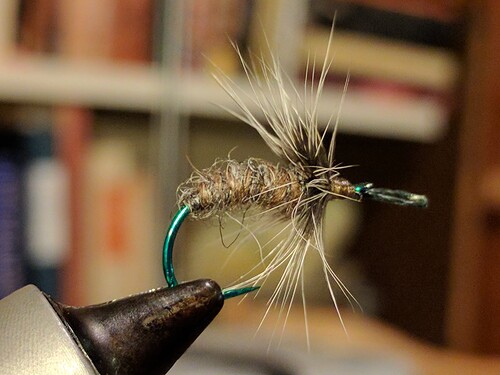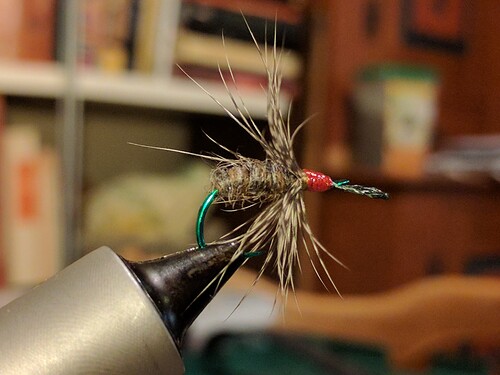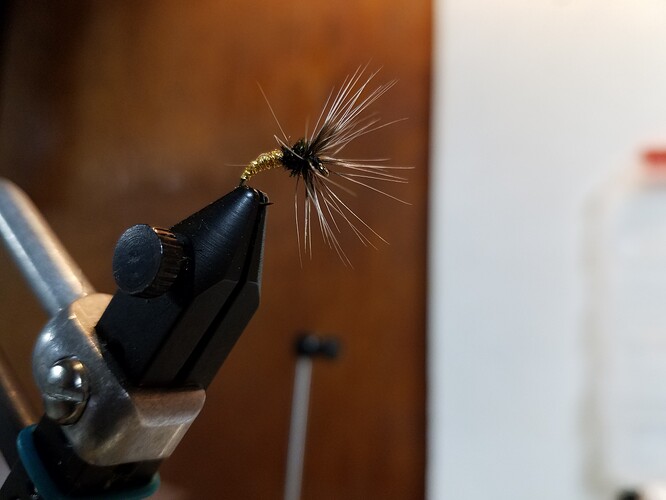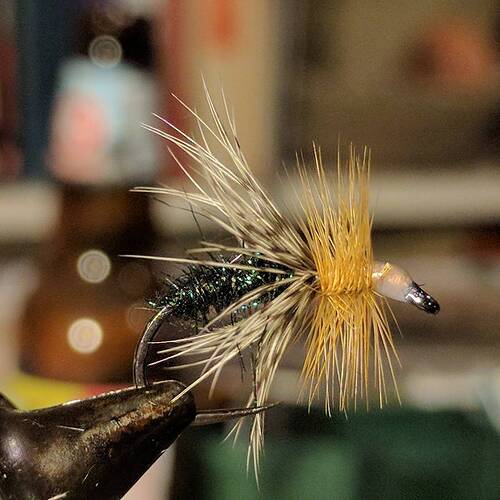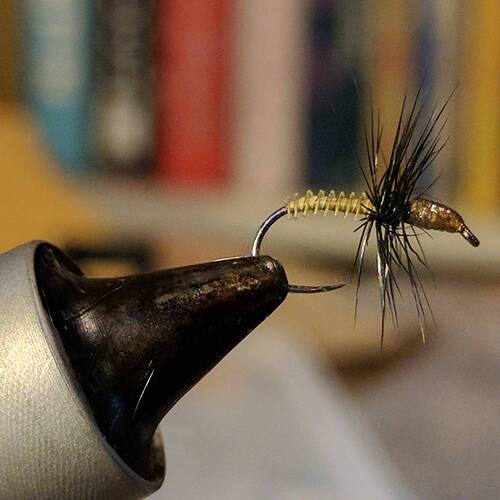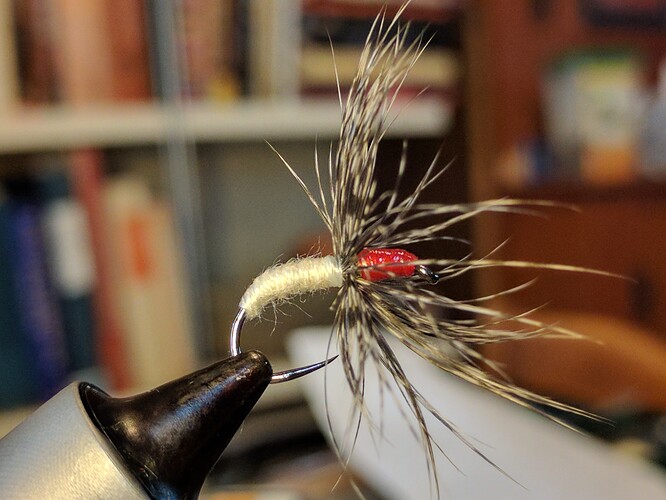Use this topic to share photos and patterns of the myriad flies, kebari, etc. that you use and want to share with others or think others may find useful. Think of this as a resource for sharing old or new patterns. They can range from patterns that you love and live by or new ones that you will be experimenting with this year.
This fly really has produced on my high gradient freestone streams the last two years. I fish it mainly when the sky is cloudless and bright sun.
hook #10-12
red thread head
Partridge hackle
peacock black Ice Dub collar
Oxford Shetland Spindrift wool body
red wire rib
Give it a try. It’s been a great fly for me!
-Tom
Thanks for sharing that Tom. I’ve seen it on your website but never knew what you used. While I’m on the other side of the country, I think it will work great here too.
I had not heard of the Copper John style of fly until I came across some Tenkara variations of the fly a few weeks ago.
I have tied a couple of my versions of the fly to try this season. Unfortunately I bought the wrong size of Ultra wire for the natural copper John Kebari version but rectified that for the olive copper John Kebari. I think it makes a difference.
My version of a Copper John Kebari:-
Hook: wet fly barbless #14
Thread: Uni-thread 8/0 Fire Orange for head & 8/0 Dark brown for body
Body: Copper Ultra wire x-small size
[NB- the correct size of wire should be ‘small’, which is why the wire is not tied as neat as it should be!]
Thorax: peacock herl
Hackle: Grouse body plumage
My version of an Olive Copper John
Hook: wet fly barbless #14
Thread: Uni-thread 8/0 Olive Dun
Body: Olive Copper Ultra wire small size
Thorax: Hare’s Ice Dub olive brown
Hackle: Grouse body plumage
Wonderful fly tying. Really great job David. ![]()
Thank you for sharing this with us. I will try it the next time I go to the mountains
for some brook trout.
Today I read a blog of a UK Tenkara angler, who despite the incessant wind that we have had recently, decided to have a go, before the season closed. He tied up a version of Dr Ishigaki ‘s one pattern’ fly and had a very successful day. Like me he fishes the slower rivers that contain lots of coarse fish, roach, chub, dace bleak,etc., but very few trout.
His tying inspired me to tie my version. Please forgive me but I rarely tie with hen or cock capes as they are very expensive here. For me I much prefer the hackles of game birds eg. partridge, grouse, woodcock and pheasant, plus the likes of snipe and starling.
Here is my version.
Hook: Hanak H390BL #14
Thread: Black Uni-thread 8/0
Hackle: Cock Pheasant neck
Traitor Renegade Kebari
It was supposed to look like the one on this webpage, But I’ve not quite gotten the hang of making the head of the kebari shorter and the body longer. Maybe next time. But otherwise, I tend to like rumpled-looking kebari and this one fits. And I’m ok with this second attempt at tying it. Maybe the fish, soon, will approve too. ![]()
http://www.sakanakokoro.com/2016/08/19/13957/
D
Yesterday in the post box, I received a small packet from a very generous person who sent me samples of 12 different Shetland Spendrift yarns. For many years, I really enjoyed tying with wool as dubbing or used directly as bodies for flies. Then for quite a while I moved on and used other things. This past year I started again and remembered how much I enjoy tying with it and how successful wool body flies are to fish. Yesterday was a very trying and stressful day for me personally, so I took some time for myself today and a part of that was tying some flies.
Hook: Owner Competition keiryu #6 (probably closest to a size 12, 1x-short, 2x wide gape wet fly hook)
Thread: Uni olive 8/0
Body: Shetland Spindrift 226 thyme (hard to tell in the image but it’s a muted green color like dried thyme)
Hackle: common starling (probably one of my favorite feathers to tie with and fish too)
Hook: Owner Competition keiryu #6
Thread: Uni black 8/0
Body: Shetland Spindrift 1270 purple haze
Hackle: India hen cape, brown
Hook: Owner Competition keiryu #6
Thread: Uni black 8/0
Body: Shetland Spindrift 286 moorgrass
Hackle: Hen cape, natural (mostly a dark grey-black with a few off-white bits)
Hook: Owner Competition keiryu #6
Thread: Uni tan 8/0
Body: Shetland Spindrift 290 oyster (I believe this what is commonly used for killer bugs)
Hackle: rooster cape, light ginger
This afternoon, I found a wicked good deal on a Whiting Brahma Hen Cape. I love these things. In all my years of western FF I’ve always been a wet fly fanatic. Probably one of the reasons why I liked tenkara so much, so quickly. So I had some fun with that and more of the Shetland Spindrift tonight.
Hook: Owner Competition keiryu #9
Thread: Uni light olive 8/0
Body: Shetland Spindrift #187 Sunrise
Hackle: Whiting Brahma Hen
Hook: Owner Competition keiryu #9
Thread: Uni light olive 8/0
Body: Shetland Spindrift #118 Moorit/Shaela
Hackle: Whiting Brahma Hen
Hook: Owner Competition keiryu #9
Thread: Uni light olive 8/0 & Uni red 6/0
Body: Shetland Spindrift #118 Moorit/Shaela
Hackle: Whiting Brahma Hen
That brahma hen in cream badger is the ticket!!! The mottled is excellent but I especially like the dark to light feathers…because it seems like the fish give the nod to it.
Cool. Thanks for posting the kebari.
It’s always nice to stumble upon a reduced price for feathers. The sometimes $70 prices I see for the feathers I want send me quickly to the exit.
David -
I got it for $14. The cheapest I’ve seen online for the same thing was $19 (not including postage), which I still didn’t think was too bad.
This was a pattern that I came up with that seemed to convert a lot of fish. It’s a gaudy granny kebari. I do them like this and a black bead head version. Both stocked and wild give it the nod. The gold is some cheap craft store thread. Thorax is peacock herl. Brahma hen for the hackle.
The black and gold is sort of a classic combo…but for some reason I have not seen many fly bodies tied in gold. Give it a try…and let me know how ya do.
Stephen -
I tied and used one similar to that last year (albeit without the Brahma hen, I used grizzley hen hackle). I don’t have any at the moment, so I can’t show a photo of it (besides, I’m technically at work too - haha). Last year I read about someone using embroidery thread for tying flies. Needless, to say, I went to our local craft shop and picked up some gold and black for wicked cheap. It works very similar too wool (though it is mostly cotton), but creates slightly smoother bodies. You can also pull the strands apart to make very thin bodies as well. On top of that it comes in several hundred colors; I think our local craft shop carries just over 250 colors of it.
That light to dark from the hen with this pattern seems to be a preference for the fish. I have tied both mottled and dark solid hackles on the same pattern and they do not seem as productive.
How did the grizzly perform? One thing about this brahma hen stuff is that it seems softer and less bristled then regular hen hackle…but I am no pro.
I think pattern falls in the category of its versatility in visibility when it come to this specific combination of elements. The combined reads as one profile, but the contrasting elements read as smaller profiles, each with the potential of having an edge in different water conditions. I really think, that this pattern is special, and as a result it is often seems to get picked up over other patterns. I notice when I see a mix of midges and larger hatching insects, this seems to do the trick.
The grizzly did alright, I don’t know if it was the hackle or the fly overall. I used quite a bit of grizzly last year and many of those flies were very successful. Yes, the Brahma is certainly softer and “webbier”; whereas others are a sometimes smoother and/or stiffer.
For example, the grizzly that I have is also hen and is also soft; it’s just that the individual hackle fibers are much smoother and trap water differently and I think serve a different purpose.
My number one pattern last year was nearly identical to the one you show above. What were the differences? They had a black thread (I also used black embroidery thread too) body. On 50% of them, I also used common starling for the hackle. The ones with starling worked best for brookies and the ones with brahma worked best for browns. All else was the same.
Last year when I couldn’t get strikes on anything else, those worked. I tied those from size 8 down to 18, with sizes 10 and 14 being the overall best sizes for me. For some reason, I only ever used grizzly hackle with the gold ones - I don’t recall why.
I head some time to do some tying today. In addition to that, the weather had been disgusting for the past two days and the ban doesn’t end for one more week.
Hook: Firehole Outdoors #633 wet fly, size 12
Thread: Uni 8/0 light tan
Body: Hareline Hare’e Ice Dub, black peacock
Back hackle: Brahma hen (original is Partridge, but I prefer Brahma and it looks nearly the same)
Front Hackle: Light ginger rooster
Hook: Firehole Outdoors #419 dry fly, size 16
Thread: Danville 8/0 Light olive
Body: Turkey biot, light olive
Hackle: Rooster cape, black
Hook: Hook: Firehole Outdoors #633 wet fly, size 12
Thread: body: unknown brand, likely 8/0, white; head: Uni 8/0 red
Body: DMC Embroidery Thread color #712
Hackle: Brahma hen
Yeah, I thought I’d read somewhere Vt was predicted to get a foot of snow this weekend.
Nice looking flies, I’ve seen ones tied like the top fly only the hackle positions were reversed, with the stiff hackle behind the soft hackle & the soft hackle tied sakasa or futsu style.
I played around today tying a Yoshi kebari. Something I found on a YouTube video yesterday. That seems to be an old way of tying, or old way of making the body of the fly. From late 50s, early 60s. It’s a method I don’t recall seeing before, but maybe widely known to others. Maybe I can post something about it tomorrow or later. I thought it had an interesting story behind it.
